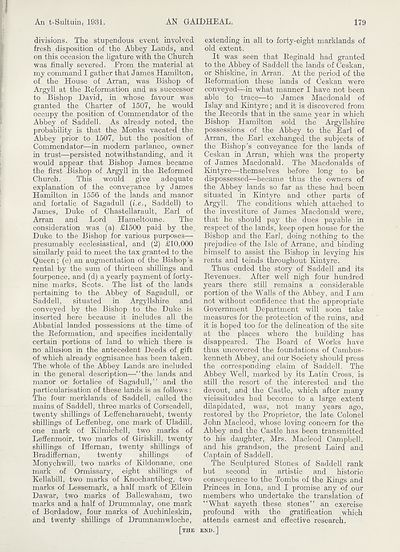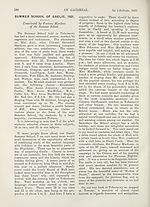An Comunn Gàidhealach Publications > Gaidheal > Volume 26, October 1930--September 1931
(231) Page 179
Download files
Complete book:
Individual page:
Thumbnail gallery: Grid view | List view

An t-Sultuin, 1931.
AN GAIDHEAL.
179
divisions. The stupendous event involved
fresh disposition of the Abbey Lands, and
on this occasion the ligature with the Church
was finally severed. From the material at
my command I gather that James Hamilton,
of the House of Arran, was Bishop of
Argyll at the Keformation and as successor
to Bishop David, in whose favour was
granted the Charter of 1507, he would
occupy the position of Commendator of the
Abbey of Saddell. As already noted, the
probability is that the Monks vacated the
Abbey prior to 1507, but the position of
Commendator—in modern parlance, owner
in trust—persisted notwithstanding, and it
would appear that Bishop James became
the first Bishop of Argyll in the Reformed
Church. This would give adequate
explanation of the conveyance by James
Hamilton in 1556 of the lands and manor
and fortalic of Sagadull (i.e., Saddell) to
James, Duke of Chastellarault, Earl of
Arran and Lord Hameltoune. The
consideration was (a) £1500 paid by the.
Duke to the Bishop for various purposes—
presumably ecclesiastical, and (2) £10,000
similarly paid to meet the tax granted to the
Queen; (c) an augmentation of the Bishop’s
rental by the sum of thirteen shillings and
fourpence, and (d) a yearly payment of forty-
nine marks, Scots. The list of the lands
pertaining to the Abbey of Sagadull, or
Saddell, situated in Argyllshire and
conveyed by the Bishop to the Duke is
inserted here because it includes all the
Abbatial landed possessions at the time of
the Reformation, and specifies incidentally
certain portions of land to which there is
no allusion in the antecedent Deeds of gift
of which already cognisance has been taken.
The whole of the Abbey Lands are included
in the general description—“the lands and
manor or fortalice of Sagadull,’’ and the
particularisation of these lands is as follows :
The four merklands of Saddell, called the
mains of Saddell, three marks of Corscadell,
twenty shillings of Leffencharaucht, twenty
shillings of Leffenbeg, one mark of Uladill,
one mark of Kilmichell, two marks of
Leffenmoir, two marks of Giriskill, twenty
shillings of Iffernan, twenty shillings of
Bradiffernan, twenty shillings of
Monychwill, two marks of Kildonane, one
mark of Ormissary, eight shillings of
Kellabill, two marks of Knochantibeg, two
marks of Lessemark, a half mark of Ellein
Dawar, two marks of Ballewaham, two
marks and a half of Drummalay, one mark
of Bo.rdadow, four marks of Auchinleskin,
and twenty shillings of Drumnamwloche,
[the
extending in all to forty-eight marklands of
old extent.
It was seen that Reginald had granted
to the Abbey of Saddell the lands of Ceskan,
or Shiskine, in Arran. At the period of the
Reformation these lands of Ceskan were
conveyed—in what manner I have not been
able to trace—to James Macdonald of
Islay and Kintyre; and it is discovered from
the Records that in the same year in which
Bishop Hamilton sold the Argyllshire
possessions of the Abbey to the Earl of
Arran, the Earl exchanged the subjects of
the Bishop’s conveyance for the lands of
Ceskan in Arran, which was the property
of James Macdonald. The Macdonalds of
Kintyre—themselves before long to be
dispossessed—became thus the owners of
the Abbey lands so far as these had been
situated in Kintyre and other parts of
Argyll. The conditions which attached to
the investiture of James Macdonald were,
that he should pay the dues payable in
respect of the lands, keep open house for the
Bishop and the Earl, doing nothing to the
prejudice of the Isle of Arrane, and binding
himself to assist the Bishop in levying his
rents and teinds throughout Kintyre.
Thus ended the story of Saddell and its
Revenues. After well nigh four hundred
years there still remains a considerable
portion of the Walls of the Abbey, and I am
not without confidence that the appropriate
Government Department will soon take
measures for the protection of the ruins, and
it is hoped too for the delineation of the site
at the places where the building has
disappeared. The Board of Works have
thus uncovered the foundations of Cambus-
kenneth Abbey, and our Society should press
the corresponding claim of Saddell. The
Abbey Well, marked by its Latin Cross, is
still "the resort of the interested and the
devout, and the Castle, which after many
vicissitudes had become to a large extent
dilapidated, was, not many years ago,
restored by the Proprietor, the late Colonel
John Macleod, whose loving concern for the
Abbey and the Castle has been transmitted
to his daughter, Mrs. Macleod Campbell,
and his grandson, the present Laird and
Captain of Saddell.
The Sculptured Stones of Saddell rank
but second in artistic and historic
consequence to the Tombs of the Kings and
Princes in Iona, and I promise any of our
members who undertake the translation of
“What sayeth these stones’’ an exercise
profound with the gratification which
attends earnest and effective research.
END.]
AN GAIDHEAL.
179
divisions. The stupendous event involved
fresh disposition of the Abbey Lands, and
on this occasion the ligature with the Church
was finally severed. From the material at
my command I gather that James Hamilton,
of the House of Arran, was Bishop of
Argyll at the Keformation and as successor
to Bishop David, in whose favour was
granted the Charter of 1507, he would
occupy the position of Commendator of the
Abbey of Saddell. As already noted, the
probability is that the Monks vacated the
Abbey prior to 1507, but the position of
Commendator—in modern parlance, owner
in trust—persisted notwithstanding, and it
would appear that Bishop James became
the first Bishop of Argyll in the Reformed
Church. This would give adequate
explanation of the conveyance by James
Hamilton in 1556 of the lands and manor
and fortalic of Sagadull (i.e., Saddell) to
James, Duke of Chastellarault, Earl of
Arran and Lord Hameltoune. The
consideration was (a) £1500 paid by the.
Duke to the Bishop for various purposes—
presumably ecclesiastical, and (2) £10,000
similarly paid to meet the tax granted to the
Queen; (c) an augmentation of the Bishop’s
rental by the sum of thirteen shillings and
fourpence, and (d) a yearly payment of forty-
nine marks, Scots. The list of the lands
pertaining to the Abbey of Sagadull, or
Saddell, situated in Argyllshire and
conveyed by the Bishop to the Duke is
inserted here because it includes all the
Abbatial landed possessions at the time of
the Reformation, and specifies incidentally
certain portions of land to which there is
no allusion in the antecedent Deeds of gift
of which already cognisance has been taken.
The whole of the Abbey Lands are included
in the general description—“the lands and
manor or fortalice of Sagadull,’’ and the
particularisation of these lands is as follows :
The four merklands of Saddell, called the
mains of Saddell, three marks of Corscadell,
twenty shillings of Leffencharaucht, twenty
shillings of Leffenbeg, one mark of Uladill,
one mark of Kilmichell, two marks of
Leffenmoir, two marks of Giriskill, twenty
shillings of Iffernan, twenty shillings of
Bradiffernan, twenty shillings of
Monychwill, two marks of Kildonane, one
mark of Ormissary, eight shillings of
Kellabill, two marks of Knochantibeg, two
marks of Lessemark, a half mark of Ellein
Dawar, two marks of Ballewaham, two
marks and a half of Drummalay, one mark
of Bo.rdadow, four marks of Auchinleskin,
and twenty shillings of Drumnamwloche,
[the
extending in all to forty-eight marklands of
old extent.
It was seen that Reginald had granted
to the Abbey of Saddell the lands of Ceskan,
or Shiskine, in Arran. At the period of the
Reformation these lands of Ceskan were
conveyed—in what manner I have not been
able to trace—to James Macdonald of
Islay and Kintyre; and it is discovered from
the Records that in the same year in which
Bishop Hamilton sold the Argyllshire
possessions of the Abbey to the Earl of
Arran, the Earl exchanged the subjects of
the Bishop’s conveyance for the lands of
Ceskan in Arran, which was the property
of James Macdonald. The Macdonalds of
Kintyre—themselves before long to be
dispossessed—became thus the owners of
the Abbey lands so far as these had been
situated in Kintyre and other parts of
Argyll. The conditions which attached to
the investiture of James Macdonald were,
that he should pay the dues payable in
respect of the lands, keep open house for the
Bishop and the Earl, doing nothing to the
prejudice of the Isle of Arrane, and binding
himself to assist the Bishop in levying his
rents and teinds throughout Kintyre.
Thus ended the story of Saddell and its
Revenues. After well nigh four hundred
years there still remains a considerable
portion of the Walls of the Abbey, and I am
not without confidence that the appropriate
Government Department will soon take
measures for the protection of the ruins, and
it is hoped too for the delineation of the site
at the places where the building has
disappeared. The Board of Works have
thus uncovered the foundations of Cambus-
kenneth Abbey, and our Society should press
the corresponding claim of Saddell. The
Abbey Well, marked by its Latin Cross, is
still "the resort of the interested and the
devout, and the Castle, which after many
vicissitudes had become to a large extent
dilapidated, was, not many years ago,
restored by the Proprietor, the late Colonel
John Macleod, whose loving concern for the
Abbey and the Castle has been transmitted
to his daughter, Mrs. Macleod Campbell,
and his grandson, the present Laird and
Captain of Saddell.
The Sculptured Stones of Saddell rank
but second in artistic and historic
consequence to the Tombs of the Kings and
Princes in Iona, and I promise any of our
members who undertake the translation of
“What sayeth these stones’’ an exercise
profound with the gratification which
attends earnest and effective research.
END.]
Set display mode to:
![]() Universal Viewer |
Universal Viewer | ![]() Mirador |
Large image | Transcription
Mirador |
Large image | Transcription
| An Comunn Gàidhealach > An Comunn Gàidhealach Publications > Gaidheal > Volume 26, October 1930--September 1931 > (231) Page 179 |
|---|
| Permanent URL | https://digital.nls.uk/125155176 |
|---|
| Description | This contains items published by An Comunn, which are not specifically Mòd-related. It includes journals, annual reports and corporate documents, policy statements, educational resources and published plays and literature. It is arranged alphabetically by title. |
|---|
| Description | A collection of over 400 items published by An Comunn Gàidhealach, the organisation which promotes Gaelic language and culture and organises the Royal National Mòd. Dating from 1891 up to the present day, the collection includes journals and newspapers, annual reports, educational materials, national Mòd programmes, published Mòd literature and music. |
|---|---|
| Additional NLS resources: |
|

